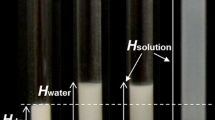Abstract
Several preparations of Cremophor El®, several of other non-ionic detergents and several components of Cremophor El were tested for their histamine-releasing capacity in dogs. Lutensol AP 10 and a derivative of 1,2-propylenglycol were ineffective, but showed excellent properties as detergents. Thus the histamine-releasing capacity was not necessarily combined with the tenside effect of the surfactants.
Oleic acid found in Tween 80 as well as in Cremophor El seems to be the most effective constituent, but the alcohol seems also to be important for the histamine-releasing capacity. The development of a non-toxic solubilizer for lipophilic drugs seems of considerable clinical interest.
Similar content being viewed by others
References
W. Lorenz, A. Doenicke, R. Meyer, H.J. Reimann, J. Kusche, H. Barth, H. Geesing, M. Hutzel andB. Weissenbacher,An Improved Method for the Determination of Histamine Release in Man: Its Application in Studies with Propanidid and Thiopentone, Europ. J. Pharmacol.19, 180–190 (1972).
W. Lorenz, A. Doenicke, R. Meyer, H.J. Reimann, J. Kusche, H. Barth, H. Geesing, M. Hutzel andB. Weissenbacher,Histamine Release in Man by Propanidid and Thiopentone: Pharmacological Effects and Clinical Consequences, Brit. J. Anaesth.44, 355–369 (1972).
A. Doenicke, W. Lorenz, R. Beigl, H. Bezecny, G. Uhlig, L. Kalmar, B. Praetorius andG. Mann,Histamine Release after Intravenous Application of Short-Acting Hypnotics: A Comparison of Etomidate, Althesin (CT 1341) and Propanidid, Brit. J. Anaesth.45, 1097–1104 (1973).
W. Lorenz, R. Meyer, A. Doenicke, A. Schmal, H.J. Reimann, M. Hutzel andE. Werle,On the Species Specificity of the Histamine Release from Mast Cell Stores by Cremophor-El, Naunyn-Schmiedebergs Arch. exp. Path. Pharmak.269, 417 (1971).
W. Lorenz, H.J. Reimann andA. Schmal,The Site of Histamine Release in Dog by Cremophor El, Abstracts 5th Int. Congr. Pharmacol., San Francisco (1972), p. 142.
W. Lorenz, H.J. Reimann, A. Schmal, R. Tauber andR. Uhlig,Histamine Release from Typical and Atypical Mast Cell Stores by Cremophor El, Naunyn-Schmiedebergs Arch. exp. Path. Pharmak. Suppl. to274, R75 (1972).
W. Lorenz, M. Thermann, H. Hamelmann, A. Schmal, D. Maroske, H.J. Reimann, J. Kusche, F. Schingale, P. Dormann andP. Keck,Influence of H 1-and H 2-Receptor Antagonists on the Effects of Histamine in the Circulatory System and on Plasma Histamine Levels. Int. Symposium on Histamine H2-Receptor Antagonists (Ed. Clive J. Wood and M. Alison Simkins; Deltakos (U.K.) Ltd. London), p. 151.
W. Lorenz,Histamine Release in Man, Agents and Actions5, 402 (1975).
R.S.J. Clarke, J.W. Dundee, R.T. Garrett, G.K. McArdle andJ.A. Sutton,Adverse Reactions To Intravenous Anaesthetics. A Survey of 100 Reports, Brit. J. Anaesth.47, 575–585 (1975).
M. Zindler, H. Yamamura andW. Wirth,Intravenöse Narkose mit Propanidid, Anaesthesiologie und Wiederbelebung74, 1 (1973).
W. Lorenz, H. Barth, M. Thermann, A. Schmal, P. Dormann andI. Niemeyer,Fluorometric Histamine Determination in Canine Plasma Under Normal Conditions, Following Application of Exogeneous Histamine and During Histamine Release by Haemaccel ®, Hoppe-Seyler's Z. Physiol. Chem.355, 1097–1111 (1974).
W. Lorenz, M. Thermann, K. Messmer, A. Schmal, P. Dormann, J. Kusche, H. Barth, R. Tauber, M. Hutzel, G. Mann andR. Uhlig,Evaluation of Histamine Elimination Curves in Plasma and Whole Blood of Several Circulatory Regions: A Method for Studying Kinetics of Histamine Release in the Whole Animal, Agents and Actions4, 336 (1974).
H. Giertz andF. Hahn,Makromolekulare Histaminliberatoren, in:Handbook of Experimental Pharmacology (Springer, Heidelberg, Berlin, New York, 1966), Vol. 18, No. 1, p. 481.
K. Müller,Untersuchungen über Cremophor El, Tenside3, 37 (1973).
Author information
Authors and Affiliations
Additional information
Supported by a grant from Deutsche Forschungsgemeinschaft (Lo 199/6).
Rights and permissions
About this article
Cite this article
Lorenz, W., Reimann, H.J., Schmal, A. et al. Histamine release in dogs by Cremophor El® and its derivatives: Oxethylated oleic acid is the most effective constituent. Agents and Actions 7, 63–67 (1977). https://doi.org/10.1007/BF01964882
Received:
Issue Date:
DOI: https://doi.org/10.1007/BF01964882




